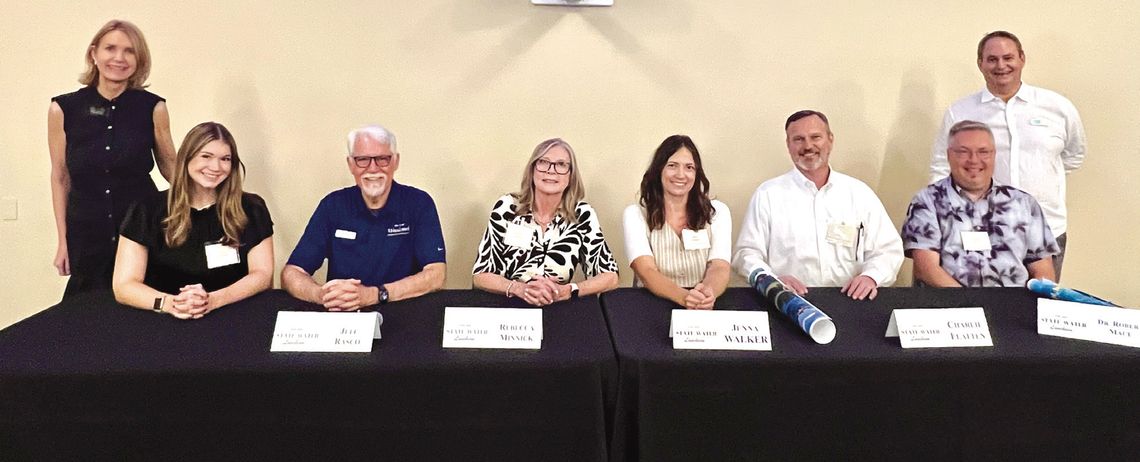The Chamber of Commerce’s State of the Water luncheon last week drew water experts, officials and conservationists to reiterate the realities of water sustainability, the victories and setbacks of conservation efforts and policy, and the dawning of regional collaborations for the future.
Leading the presentation was David Baker, Executive Director of the Watershed Association. He was joined by a panel of speakers composed of officials from Wimberley, Woodcreek, and Hays County; water and environmental experts from the Meadows Center at Texas State University in San Marcos; and conservationists from the Hays Trinity Watershed Conservation District and the Watershed Association.
David Baker expressed the acute concern over water sustainability, with a specific focus on Wimberley. He pointed out the importance of water for the local economy, with nearly a million tourists visiting Wimberley, whose “brand,” he asserted, was Jacob’s Well and Blue Hole. The closing of Jacob’s Well has meant a loss of $450,000 each year in revenue for Wimberley. He warned that water resources are not being sustainably managed, with many planned projects ultimately leading to water depletion.
Baker told listeners that the projected population growth for the region, by 2050, is 12 million people who will further strain water resources. To compound matters, he said, the incidence of rainfall is decreasing, and the sharp increase of wells being drilled to provide water for homesteads on less than 10-acre parcels of land is leading to further stress on the aquifers.
Baker also explained that Jacob’s Well is an unusually sensitive feature in terms of its ability to recharge and asked, “How do we manage a situation where we have such a sensitive aquifer?”
He also pointed out that water projects typically reduce the availability of water for other regional water users. “Groundwater and surface water are interconnected and most water supply projects are not resilient.”
After outlining the challenges, he spoke about some of the conservation victories of recent years, commending the cities of Wimberley and Woodcreek for passing the One Water resolution and the subsequent construction of the Wimberley Library and Jacob’s Well Elementary school using those principles, and the adoption, by many residents, of rainwater harvesting as a regional water management strategy. Other victories he named included a 2025 emerging visionary incubator, the purchase of the Karst Canyon acreage, and the “Art for Water” kite educational exhibition.
Regional collaboration, Baker said, is a key strategy for the future. Recently, the cities of Wimberley and Wood Creek, and Hays County signed an interlocal agreement to work on sustainable water and wastewater for Western Hays County. The agreement is expected to build trust and coordination across the jurisdictions.
Baker introduced Jenna Walker, Director of Watershed Services at the Meadows Center for Water and the Environment at Texas State University to talk about the Blanco Cypress Watershed Protection Plan, an example of a collaboration between the Meadows Center, the Watershed Association, cities and county.
Looking ahead, Baker talked about a General Land Office grant, for the city of Wimberley, in the works to be completed at the end of 2025.
“We’re writing a one water resiliency plan. It’s going to be a road map for the future of smart land use, water use, community resilience, economic and housing strategies, and regional collaboration.”
Following Baker’s remarks, Charlie Flatten, General Manager of the Hays Trinity Groundwater Conservation District spoke about water allocation and management in Hays County, indicating the area uses about 2.3 billion gallons per year.
“With current growth rates, the remaining allocation could be exhausted within two decades,” he said, implying the need for careful planning and decision- making.
Drought has severely impacted many areas of the state, with even desert areas suffering from below-average drought levels. According to Flatten, the 2023 drought was particularly devastating, when every Hill Country river registered a no-flow condition, and all aquifers recorded historically low levels.
“We have this very persistent bull’s eye of drought that’s been hovering over Kendall and Bandera County and creeping up to the surrounding counties, which includes Western Hays County.
So we’ve been in some form of abnormally high drought, extreme drought, actually, for the past four or five years.”
Flatten also made a few remarks about recent legislation that was vetoed in June.
“S.B. 2660, which worked into S.B. 1253, would have given Western Hays County the same property rights that your neighbors in Eastern Hays County and most of the rest of the state take for granted. Senator Perry, Chair of the Rural Affairs Committee, proposed S.B. 2660 [as it relates to the authority of the Hays Trinity Groundwater Conservation District] to create a nominal production fee on non-exempt wells to create sustainable revenue for the district and to provide cost incentives to developers and builders to incorporate water conservation systems in new developments.”
“Despite support from the cities of Woodcreek and Wimberley, support from the business community and thousands and thousands of signatures from citizens, and making it through the Senate, unanimously, and the House with a near unanimous vote, S.B. 1253 stalled out at the Governor’s desk where he vetoed it.”
“That’s a conversation we have to continue,” Flatten said.
Next at the microphone was Dr. Robert Mace, Executive Director and Chief Water Policy Officer of the Meadows Center for Water and Environment.
Mace was introduced by Baker, who noted his credentials. “Robert has over thirty years of experience in water resources and policy.” Besides noting Mace’s degrees in geophysics, hydrology, and a PhD in hydrogeology from the University of Texas at Austin, Baker told listeners Mace “published a program on groundwater sustainability in 2022 and is currently working on a book about water resources and climate change.”
Regional and state water plans were the focus of Mace’s talk.
“Texas is expected to grow about 73% over the next fifty years according to our current water plan and the donut counties, counties around the urban centers, are growing much more quickly [than the plan expected.] Hays County is expected to triple in population over the next fifty years,” he said.
“Since these people are not bringing water with them, we have to find water for them. Most of these needs are coming from the municipality. Then, to top it all off, the current water plan is way too conservative in accounting for growth.”
While he applauded rainwater harvesting, he said rainwater harvesting can’t be designed to be reliable. “I don’t know how the Hill Country meets its needs without water imports,” Mace said.
On a positive note, Mace said that the Hays Trinity Groundwater Conservation District is actually managing water resources.
“Not all groundwater districts manage the resource. But the [HTGCD] district is managing, [despite being] under a lot of stress with lawsuits and challenges. That’s good news if you believe in groundwater management.”
After supportive remarks from Wimberley’s Mayor pro tem, Rebecca Minnick, Woodcreek’s Mayor, Jeff Rasco and Hays County Commissioner, Morgan Hammer, the presentation drew to a close.






